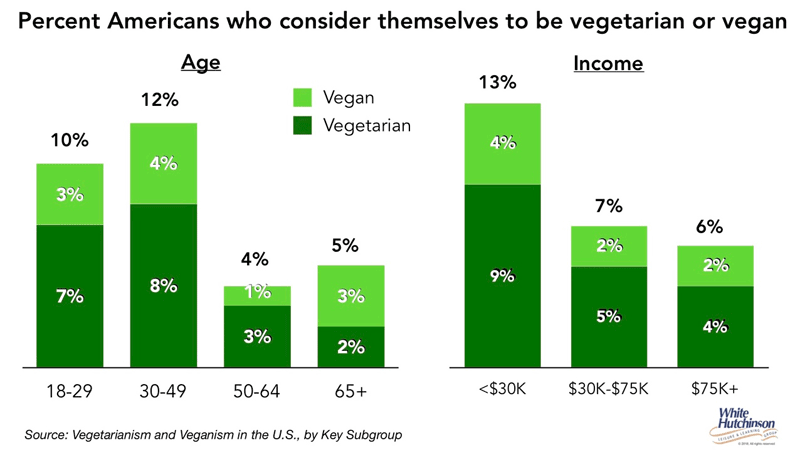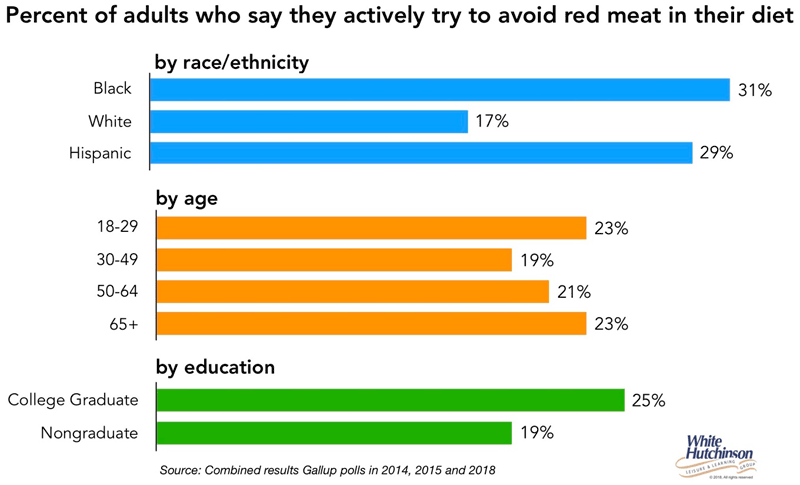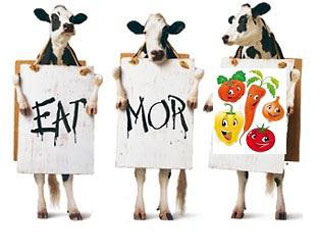
Vol. XVIII, No. 7, August 2018
- Editor's corner
- Brailling the leisure culture
- Structure changes responsible for baby bust?
- The rise of festival competition to community-based entertainment venues
- Americans' diets are diverse
- The rise of agritainment/agritourism
- The changing composition of bowlers
- Who is "middle class" and "upper income"?
- What we eat has changed
- Digital screen time on the increase
What we eat has changed
Back in our April article Move over cows, here come the plants, we discussed how consumers' diet and protein preferences are shifting from meat to plant-forward and plant-based proteins. Among that population are vegetarians (abstain from eating meat) and vegans (reject all animal products). But just how significant a population are they?
A July 2018 survey by Gallup has given us the answer. 5% of Americans are vegetarians and 3% are vegan. That adds up to one-in-twelve non-meat eaters (8%). However, the percentages vary by age and incomes.

Adults under age 50 score highest as vegans or vegetarians as do, surprisingly, adults with incomes under $30,000. Political ideology also shows a diversity of preference. Liberals score even higher with 11% vegetarian and 5% vegan for a total of 16% while conservatives are among the lowest at 2% and 2% respectively.
However, vegetarians and vegans are not the only consumers avoiding meat. Pescatarians eat fish, but not meat. And an even larger percentage of the population is reducing their consumption of meat, especially red meat, what is known as flexitarianism.

There have been a number of other surveys looking at the flexitarian trend. NPD found that 12% of consumers who do not consider themselves vegan or vegetarian are regularly using plant-based alternatives versus animal-based foods. A survey by Mattson found that 29% of the population are flexitarians, either cutting down on meat (20%) or mostly following a vegetarian diet, but occasionally eating meat (9%). A Nielsen survey found 39% , and a Datessential survey found 44% of Americans are trying to eat less meat and actively trying to include more plant-based foods in their diets (we believe this was inclusive of vegans, vegetarians and flexitarians).

Depending on which survey data is used, when you add the percentages together - the vegetarians, vegans and flexitarians- you end up with somewhere between one-fifth (20%) to two-fifths (39%/44%) of Americans either not eating any meat or seriously cutting back on meat and animal-based foods.
This no or limited meat/animal product consumption shift in Americans diets has taken place in a rather short period of time and seems to be accelerating. We're even seeing things like consumers demanding their coffee shops offer plant-based alternatives to dairy milk such as soy, almond and now oat imitation milk that is fast edging out the former two alternatives.
Futurist Faith Popcorn and her BrainReserve company have a documented 95% accuracy rate on forecasting culture trends. Faith, as part of what she has labeled the EcoPalypse Now trend, that environmental concerns will rise as a key issue for consumers and a powerful purchase motivator, is warning carnivores to beware as the environmental impact of meat will become a huge consumer issue, that meat will become the new tobacco, as its detrimental effects to the planet will push it into extinction, to be replaced by mushroom and plant-based “meats.”
One of the reasons our company does so much research on trends, including on food and drink, is so when we design and produce projects for our clients, their offerings and experiences will be in sync with current and future consumer wants, needs and preferences. Right now when working with our executive chef and restaurant operations team to develop menus for our clients' projects, we are making sure there is a minimum of 30% plant-based only items. This not only includes entrees, but also sandwiches, appetizers, small plates, snacks and even desserts. We're also developing meat dishes that are more plant-forward with smaller portions of meat.
Just offering salads and veggie wraps no longer will satisfy the plant-oriented consumers. The vegan and vegetarian offerings need to be diverse, tasty and craveable. Datassential's research found that 85% of consumers believe plant-based foods can be just as satisfying as animal proteins. Naturally colorful fruits and vegetables are also ideal for garnering consumers' attention and lend themselves to being very Instagrammable.
Vol. XVIII, No. 7, August 2018
- Editor's corner
- Brailling the leisure culture
- Structure changes responsible for baby bust?
- The rise of festival competition to community-based entertainment venues
- Americans' diets are diverse
- The rise of agritainment/agritourism
- The changing composition of bowlers
- Who is "middle class" and "upper income"?
- What we eat has changed
- Digital screen time on the increase


